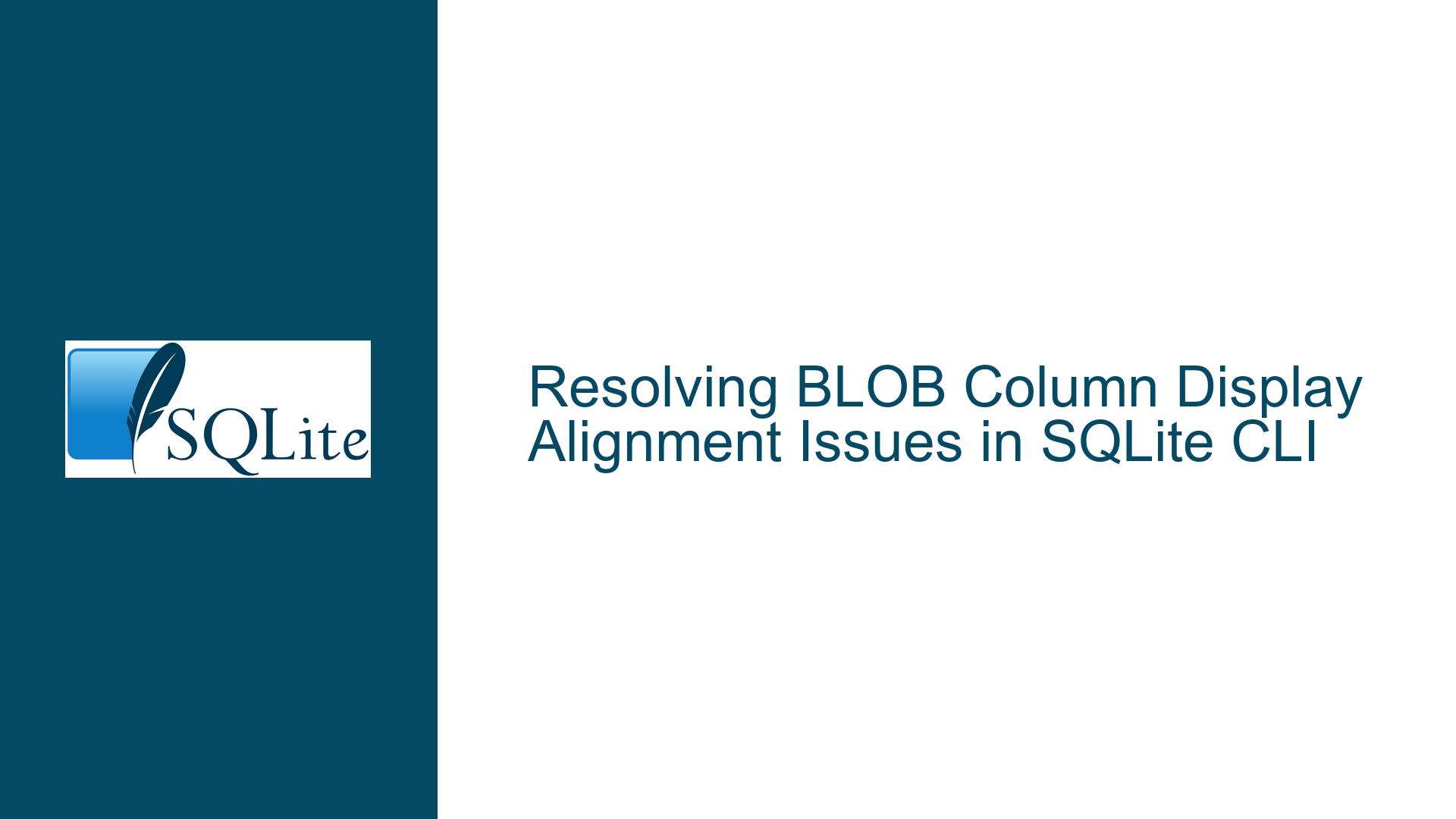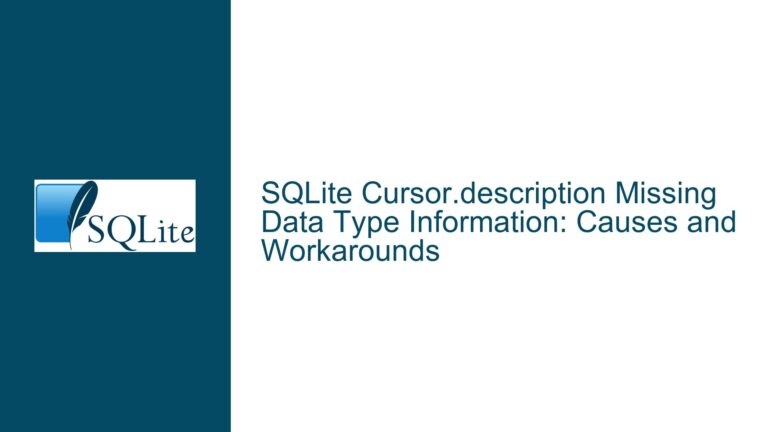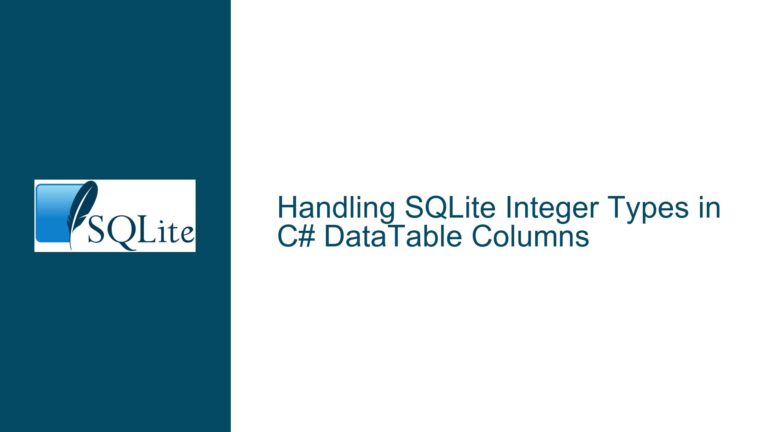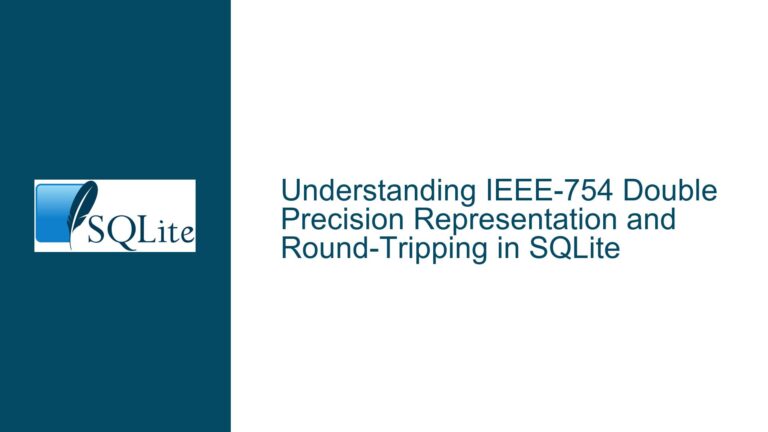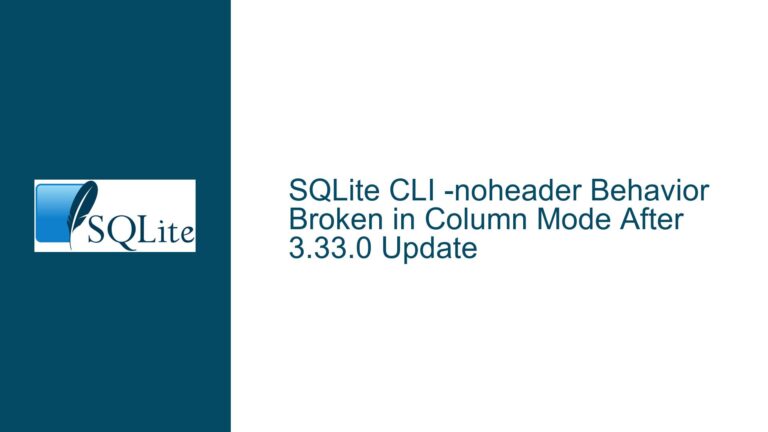Resolving BLOB Column Display Alignment Issues in SQLite CLI
BLOB Column Rendering Discrepancies in SQLite Command-Line Interface (CLI)
When working with BLOB (Binary Large Object) columns in SQLite via its command-line interface (CLI), users may encounter unexpected rendering behavior when attempting to display table data using the .mode box output format. This manifests as misaligned columns, truncated BLOB representations, or empty spaces where BLOB content should appear. The problem becomes evident when executing SELECT queries on tables containing BLOB columns, particularly when the BLOB data includes non-printable bytes or hexadecimal values that are not automatically interpreted as displayable text.
The core challenge arises from how the SQLite CLI handles binary data representation in box-drawing mode, which uses Unicode characters to create visually appealing table borders. In standard .mode box configurations prior to SQLite version 3.38.0, BLOB values containing non-ASCII or zero-byte sequences may fail to render properly, causing column width calculation errors and subsequent layout distortion. This behavior creates confusion for developers expecting consistent tabular output across all column types, especially when comparing textual data with binary payloads.
A typical reproduction scenario involves:
- Creating a table with mixed data types (INTEGER, BLOB, TEXT)
- Inserting records containing explicit BLOB values via hexadecimal notation (e.g.,
x'0500') - Attempting to display results using
.mode box - Observing incomplete or misformatted BLOB column output
Example problematic output:
┌───┬───┬───┐
│ a │ b │ c │
├───┼───┼───┤
│ a │ │ c │
└───┴───┴───┘
Here, the BLOB column b appears empty despite containing valid binary data, due to rendering limitations in older CLI versions. This issue persists across multiple platform implementations and is not specific to particular operating systems or terminal emulators, making it a universal pain point for SQLite users handling binary data through the CLI.
Underlying Factors Contributing to BLOB Display Irregularities
The misrendering of BLOB columns in SQLite CLI stems from three primary technical factors interacting within the command-line environment:
1. Column Width Calculation Heuristics
The box-drawing mode employs dynamic column width determination based on the content of result set rows. When encountering BLOB values, the CLI attempts to interpret the binary data as printable characters using its internal utf8_printf() function. Binary sequences containing null bytes (0x00) or control characters trigger early termination of string interpretation, resulting in zero-length string representations. This faulty width calculation then propagates through the table rendering engine, causing columns to collapse to minimum widths and subsequent misalignment of adjacent columns.
2. BLOB-to-String Conversion Limitations
SQLite’s CLI implements type-specific display handlers for different storage classes. While TEXT and NUMERIC types have straightforward string representations, BLOB handling requires special consideration. The default BLOB display mechanism uses hexadecimal encoding with x'...' notation only when explicitly cast or when containing non-printable characters. However, in box mode prior to version 3.38.0, this conversion was not automatically applied during table rendering, leading to raw binary interpretation attempts that failed to produce visible output for certain byte sequences.
3. Version-Specific Output Formatting Enhancements
Ongoing development of SQLite’s CLI introduced improved formatting options that addressed historical limitations in binary data representation. Versions prior to 3.38.0 lacked the necessary escape sequence handling and quoting mechanisms required to properly display BLOB values in box mode. The introduction of qbox mode in 3.38.0 and subsequent refinements in 3.39.0 resolved these issues through systematic application of value quoting and explicit BLOB notation, but users operating with older CLI versions remain susceptible to the original rendering defects.
Comprehensive Resolution Strategy for BLOB Display Consistency
Step 1: Verify SQLite CLI Version Compatibility
Execute SELECT sqlite_version(); to determine the current runtime version. The BLOB rendering improvements first appeared in 3.38.0, with subsequent refinements in 3.39.0. For production systems requiring stable releases, 3.38.5 or later is recommended. Upgrade paths vary by platform:
- Windows: Download precompiled binaries from sqlite.org/download.html
- Linux: Use package manager updates or compile from source:
wget https://www.sqlite.org/src/tarball/sqlite.tar.gz?r=release -O sqlite.tar.gz tar xzf sqlite.tar.gz cd sqlite/ ./configure --enable-fts5 --enable-json1 make sudo make install - macOS: Utilize Homebrew with
brew update && brew upgrade sqlite
Step 2: Implement QBOX Mode for BLOB-Aware Formatting
Newer SQLite versions provide the qbox output mode, which combines box-drawing aesthetics with proper value quoting and BLOB representation. Activate via:
.mode qbox
.headers on
SELECT * FROM example;
This produces formatted output with explicit BLOB notation:
┌─────┬─────────┬─────┐
│ a │ b │ c │
├─────┼─────────┼─────┤
│ 'a' │ x'0500' │ 'c' │
└─────┴─────────┴─────┘
The qbox mode automatically applies these critical formatting rules:
- Quotes all string values to distinguish from numeric types
- Converts BLOBs to standard
x'...'hexadecimal notation - Maintains consistent column widths through accurate length calculation
- Preserves box-drawing characters while handling special byte sequences
Step 3: Customize Box Mode Parameters for Legacy Systems
For environments constrained to SQLite versions between 3.36.0 and 3.38.0, manually configure box mode with enhanced display parameters:
.mode box --wrap 60 --quote
.headers on
SELECT * FROM example;
This combination:
- Enables value quoting similar to
qboxmode - Sets line wrapping to 60 characters (prevents terminal overflow)
- Forces explicit BLOB representation through quoting mechanisms
- Maintains backward compatibility while improving output readability
Step 4: Implement BLOB Casting for Cross-Version Compatibility
When working across multiple SQLite versions, explicitly cast BLOB columns to their hexadecimal representation:
SELECT a, hex(b) AS b_hex, c FROM example;
Combine with box mode formatting:
┌───┬────────┬───┐
│ a │ b_hex │ c │
├───┼────────┼───┤
│ a │ 0500 │ c │
└───┴────────┴───┘
This approach ensures human-readable BLOB display but requires:
- Manual column alias management
- Awareness of hexadecimal representation conventions
- Additional query syntax for routine inspection tasks
Step 5: Configure Persistent Formatting Settings
For frequent CLI users, persist output preferences using .sqliterc configuration files. Create or update ~/.sqliterc with:
.headers on
.mode qbox
This automatically applies optimal formatting settings across all CLI sessions while maintaining compatibility with version-specific features.
Step 6: Utilize Alternative Output Modes for Debugging
When detailed BLOB inspection is required, employ these complementary modes:
- Hexadecimal Dump Mode:
.mode hex SELECT * FROM example;Produces:
a b c --- ------ --- a 0500 c - Markdown Table Format:
.mode markdown SELECT * FROM example;Generates:
| a | b | c | |-----|------|-----| | a | | c | - Quote-Separated Values:
.mode quote SELECT * FROM example;Outputs:
"a","","c"
Step 7: Implement Programmatic BLOB Validation
To confirm BLOB integrity regardless of display formatting, use SQLite’s built-in functions:
SELECT
a,
length(b) AS blob_length,
typeof(b) AS data_type,
c
FROM example;
This query verifies:
- Physical presence of BLOB data through length calculation
- Storage class confirmation via
typeof() - Coexistence with other column types
Step 8: Develop Custom Display Functions for Complex BLOBs
For advanced use cases involving structured binary data, register application-defined functions to interpret BLOB content:
#include <sqlite3.h>
#include <stdio.h>
static void blob_to_str(sqlite3_context *context, int argc, sqlite3_value **argv) {
const unsigned char *blob = sqlite3_value_blob(argv[0]);
int size = sqlite3_value_bytes(argv[0]);
char *str = sqlite3_malloc(size*2 + 1);
for(int i=0; i<size; i++){
sprintf(&str[i*2], "%02X", blob[i]);
}
sqlite3_result_text(context, str, -1, sqlite3_free);
}
// Register function in CLI:
.load ./blob_extension
SELECT a, blob_to_str(b) AS b_str, c FROM example;
This extension provides consistent hexadecimal representation across all output modes while maintaining database portability.
Step 9: Audit Data Insertion Patterns
Ensure BLOB values are properly encoded during insertion to prevent silent corruption:
-- Explicit hexadecimal notation
INSERT INTO example VALUES ('a', x'0500', 'c');
-- Binary string handling
INSERT INTO example VALUES ('b', CAST('binary_data' AS BLOB), 'd');
-- File content ingestion
INSERT INTO example VALUES ('c', readfile('image.png'), 'e');
Combine with PRAGMA encoding = 'UTF-8'; to maintain compatibility between text and binary columns.
Step 10: Monitor CLI Enhancement Adoption
Track SQLite’s ongoing CLI improvements through these channels:
- Official changelog at sqlite.org/changes.html
- Forum announcements at sqlite.org/forum
- Source code repository at www.sqlite.org/src
- Security advisory mailing lists
Proactive version monitoring ensures early adoption of formatting improvements and compatibility fixes related to BLOB handling and CLI output rendering.
